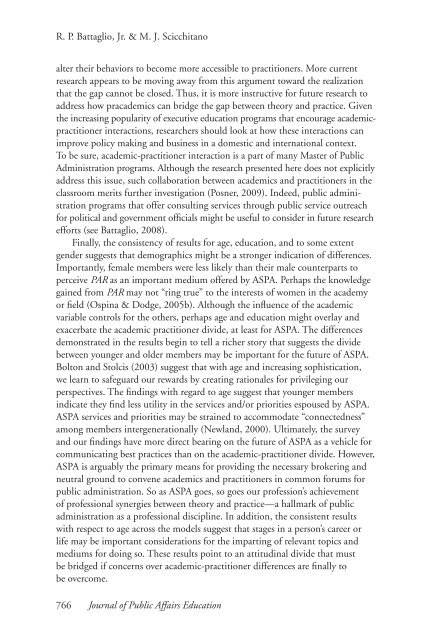Building Bridges? An Assessment of Academic and Practitioner ...
Building Bridges? An Assessment of Academic and Practitioner ...
Building Bridges? An Assessment of Academic and Practitioner ...
Create successful ePaper yourself
Turn your PDF publications into a flip-book with our unique Google optimized e-Paper software.
R. P. Battaglio, Jr. & M. J. Scicchitanoalter their behaviors to become more accessible to practitioners. More currentresearch appears to be moving away from this argument toward the realizationthat the gap cannot be closed. Thus, it is more instructive for future research toaddress how pracademics can bridge the gap between theory <strong>and</strong> practice. Giventhe increasing popularity <strong>of</strong> executive education programs that encourage academicpractitionerinteractions, researchers should look at how these interactions canimprove policy making <strong>and</strong> business in a domestic <strong>and</strong> international context.To be sure, academic-practitioner interaction is a part <strong>of</strong> many Master <strong>of</strong> PublicAdministration programs. Although the research presented here does not explicitlyaddress this issue, such collaboration between academics <strong>and</strong> practitioners in theclassroom merits further investigation (Posner, 2009). Indeed, public administrationprograms that <strong>of</strong>fer consulting services through public service outreachfor political <strong>and</strong> government <strong>of</strong>ficials might be useful to consider in future researchefforts (see Battaglio, 2008).Finally, the consistency <strong>of</strong> results for age, education, <strong>and</strong> to some extentgender suggests that demographics might be a stronger indication <strong>of</strong> differences.Importantly, female members were less likely than their male counterparts toperceive PAR as an important medium <strong>of</strong>fered by ASPA. Perhaps the knowledgegained from PAR may not “ring true” to the interests <strong>of</strong> women in the academyor field (Ospina & Dodge, 2005b). Although the influence <strong>of</strong> the academicvariable controls for the others, perhaps age <strong>and</strong> education might overlay <strong>and</strong>exacerbate the academic practitioner divide, at least for ASPA. The differencesdemonstrated in the results begin to tell a richer story that suggests the dividebetween younger <strong>and</strong> older members may be important for the future <strong>of</strong> ASPA.Bolton <strong>and</strong> Stolcis (2003) suggest that with age <strong>and</strong> increasing sophistication,we learn to safeguard our rewards by creating rationales for privileging ourperspectives. The findings with regard to age suggest that younger membersindicate they find less utility in the services <strong>and</strong>/or priorities espoused by ASPA.ASPA services <strong>and</strong> priorities may be strained to accommodate “connectedness”among members intergenerationally (Newl<strong>and</strong>, 2000). Ultimately, the survey<strong>and</strong> our findings have more direct bearing on the future <strong>of</strong> ASPA as a vehicle forcommunicating best practices than on the academic-practitioner divide. However,ASPA is arguably the primary means for providing the necessary brokering <strong>and</strong>neutral ground to convene academics <strong>and</strong> practitioners in common forums forpublic administration. So as ASPA goes, so goes our pr<strong>of</strong>ession’s achievement<strong>of</strong> pr<strong>of</strong>essional synergies between theory <strong>and</strong> practice—a hallmark <strong>of</strong> publicadministration as a pr<strong>of</strong>essional discipline. In addition, the consistent resultswith respect to age across the models suggest that stages in a person’s career orlife may be important considerations for the imparting <strong>of</strong> relevant topics <strong>and</strong>mediums for doing so. These results point to an attitudinal divide that mustbe bridged if concerns over academic-practitioner differences are finally tobe overcome.766 Journal <strong>of</strong> Public Affairs Education
















